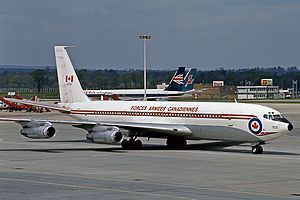
The Northrop Grumman E-8 Joint Surveillance Target Attack Radar System is a retired United States Air Force (USAF) airborne ground surveillance, battle management and command and control aircraft. It tracks ground vehicles and some aircraft, collects imagery, and relays tactical pictures to ground and air theater commanders. The aircraft was operated by both active duty USAF and Air National Guard units and also carried specially trained U.S. Army personnel as additional flight crew until its retirement in 2023.
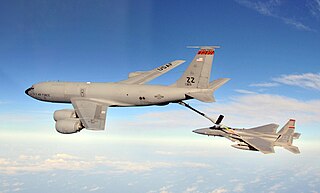
The Boeing KC-135 Stratotanker is an American military aerial refueling tanker aircraft that was developed from the Boeing 367-80 prototype, alongside the Boeing 707 airliner. It has a narrower fuselage and is shorter than the 707. Boeing gave the aircraft the internal designation of Model 717. The KC-135 was the United States Air Force (USAF)'s first jet-powered refueling tanker and replaced the KC-97 Stratofreighter. The KC-135 was initially tasked with refueling strategic bombers, but it was used extensively in the Vietnam War and later conflicts such as Operation Desert Storm to extend the range and endurance of US tactical fighters and bombers.
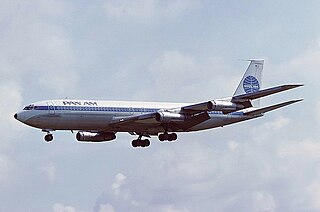
The Boeing 707 is an early American long-range narrow-body airliner, the first jetliner developed and produced by Boeing Commercial Airplanes. Developed from the Boeing 367-80 prototype first flown in 1954, the initial 707-120 first flew on December 20, 1957. Pan Am began regular 707 service on October 26, 1958. With versions produced until 1979, the 707 is a swept wing quadjet with podded engines. Its larger fuselage cross-section allowed six-abreast economy seating, retained in the later 720, 727, 737, and 757 models.
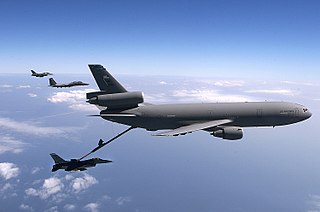
The McDonnell Douglas KC-10 Extender is an American tanker and cargo aircraft operated by the United States Air Force (USAF). A military version of the three-engine DC-10 airliner, the KC-10 was developed from the Advanced Tanker Cargo Aircraft Program. It incorporates military-specific equipment for its primary roles of aerial refueling and transport. It was developed to supplement the KC-135 Stratotanker following experiences in Southeast Asia and the Middle East. The KC-10 was the second McDonnell Douglas transport aircraft to be selected by the Air Force following the C-9. A total of 60 KC-10s were produced for the USAF. The Royal Netherlands Air Force operated two similar tankers designated KDC-10 that were converted from DC-10s.

The Airbus A310 MRTT Multi-Role Tanker Transport is a military air-to-air refuelling, or in-flight refuelling tanker transport aircraft, capable of operating multi-role missions. The A310 MRTT tanker aircraft is a subsequent development from the earlier Airbus A310 MRT Multi-Role Transport, which was a military transport aircraft for passengers, cargo, and medical evacuation. The A310 MRT and A310 MRTT are both specialist military conversions of existing airframes of the civilian Airbus A310-300C wide-bodied passenger jet airliner.

The Airbus CC-150 Polaris is the designation for the civilian Airbus A310-300s which have been converted into multi-purpose, long-range jet aircraft for passenger, freight or medical transport and mid-air refueling for the Royal Canadian Air Force.

The Airbus A330 Multi Role Tanker Transport (MRTT) is a European aerial refuelling and military transport aircraft based on the civilian Airbus A330. A total of 15 countries have placed firm orders for approximately 78 aircraft, of which 60 had been delivered by 30 June 2024. A version of the A330 MRTT, the EADS/Northrop Grumman KC-45, was selected by the United States Air Force for its aerial tanker replacement programme, but the programme was cancelled.

The Boeing C-135 Stratolifter is a transport aircraft derived from the prototype Boeing 367-80 jet airliner in the early 1950s. It has a narrower fuselage and is shorter than the 707. Boeing gave the aircraft the internal designation of Model 717, a name later assigned to a completely different aircraft.
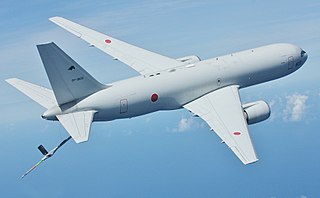
The Boeing KC-767 is a military aerial refueling tanker and transport aircraft developed from the Boeing 767-200ER. The tanker received the designation KC-767A, after being selected by the U.S. Air Force (USAF) initially to replace older KC-135Es. In December 2003, the contract was frozen and later canceled due to corruption allegations.

The Bombardier Challenger 600 series is a family of business jets developed by Canadair after a Bill Lear concept, and then produced from 1986 by its new owner, Bombardier Aerospace. At the end of 1975, Canadair began funding the development of LearStar 600, and then bought the design for a wide-cabin business jet in April 1976. On 29 October, the programme was launched, backed by the Canadian federal government, and designed to comply with new FAR part 25 standards.

The Canadair CL-44 was a Canadian turboprop airliner and cargo aircraft based on the Bristol Britannia that was developed and produced by Canadair in the late 1950s and early 1960s. Although innovative, only a small number of the aircraft were produced for the Royal Canadian Air Force (RCAF), and for commercial operators worldwide.

The Canadair CL-66 was a turboprop version of the civilian Convair CV-440 Metropolitan. The CC-109 Cosmopolitan or "Cosmo" in RCAF service became the standard VIP aircraft as well as replacing the Douglas Dakota and the North American B-25 Mitchell in light transport duties. After a lengthy career stretching into the 1990s, the CC-109 was replaced by the CC-142 Dash 8 and CC-144 Challenger.

The Canadair CF-104 Starfighter is a modified version of the Lockheed F-104 Starfighter supersonic fighter aircraft built in Canada by Canadair under licence. It was primarily used as a ground attack aircraft, despite being designed as an interceptor. It served with the Royal Canadian Air Force (RCAF) and later the Canadian Armed Forces (CAF) until it was replaced by the McDonnell Douglas CF-18 Hornet in 1987.
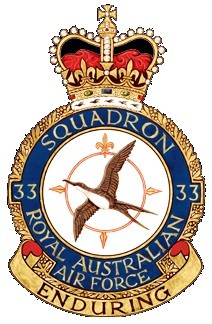
No. 33 Squadron is a Royal Australian Air Force (RAAF) strategic transport and air-to-air refuelling squadron. It operates Airbus KC-30A Multi Role Tanker Transports from RAAF Base Amberley, Queensland. The squadron was formed in February 1942 for service during World War II, operating Short Empire flying boats and a variety of smaller aircraft. By 1944 it had completely re-equipped with Douglas C-47 Dakota transports, which it flew in New Guinea prior to disbanding in May 1946.
Canada Dry was the nickname for two Canadian Forces bases in Doha, Qatar during the first Gulf War. The two bases, named Canada Dry One and Canada Dry Two, housed land and air elements.

437 Transport Squadron is a unit of the Canadian Armed Forces under the Royal Canadian Air Force, based at CFB Trenton in Ontario. The unit operates the CC-150 Polaris, the CC-330 Husky, and is responsible for long range military and VIP transportation.
The Royal Canadian Air Force (RCAF) maintains specialised aircraft to transport Canada's monarch and/or other members of the royal family, the governor general, prime minister, other senior members of the Government of Canada, and other dignitaries. A small fleet of dedicated executive government transport aircraft are organised into two RCAF squadrons. Other RCAF combat and transport helicopters and fixed-wing aircraft, chartered civilian aircraft, and occasionally scheduled commercial flights may also be used to meet Canada's VIP air transport requirements.

The EADS/Northrop Grumman KC-45 was a proposed aerial refueling tanker aircraft based on the Airbus A330 MRTT. The United States Air Force (USAF) had ordered 179 KC-45As in the first stage of replacing the aging Boeing KC-135 Stratotanker tankers currently in service. However, the contest was reopened in July 2008, after Boeing's protest of the award was upheld. In response to the new contest, on 8 March 2010, Northrop Grumman announced it was abandoning its bid for the new contract, with its CEO stating that the revised bid requirement favoured Boeing. On 20 April 2010, EADS announced it was re-entering the competition and entered a bid with the KC-45. Eventually, the USAF selected the Boeing KC-46 Pegasus.

The Boeing C-137 Stratoliner is a retired VIP transport aircraft derived from the Boeing 707 jet airliner used by the United States Air Force. Other nations also bought both new and used 707s for military service, primarily as VIP or tanker transports. In addition, the 707 served as the basis for several specialized versions, such as the E-3 Sentry AWACS aircraft. The designation C-18 covers several later variants based on the 707-320B/C series. The C-137 should not be confused with the similar Boeing C-135 Stratolifter; although they share a common ancestor the two aircraft have different fuselages, among other structural differences.
